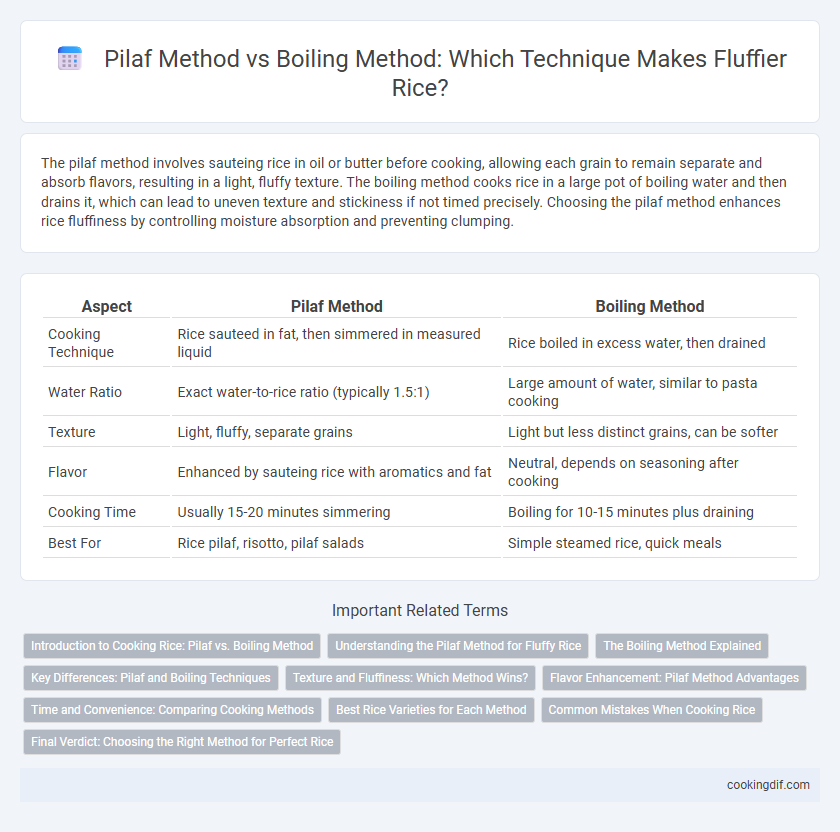The pilaf method involves sauteing rice in oil or butter before cooking, allowing each grain to remain separate and absorb flavors, resulting in a light, fluffy texture. The boiling method cooks rice in a large pot of boiling water and then drains it, which can lead to uneven texture and stickiness if not timed precisely. Choosing the pilaf method enhances rice fluffiness by controlling moisture absorption and preventing clumping.
Table of Comparison
| Aspect | Pilaf Method | Boiling Method |
|---|---|---|
| Cooking Technique | Rice sauteed in fat, then simmered in measured liquid | Rice boiled in excess water, then drained |
| Water Ratio | Exact water-to-rice ratio (typically 1.5:1) | Large amount of water, similar to pasta cooking |
| Texture | Light, fluffy, separate grains | Light but less distinct grains, can be softer |
| Flavor | Enhanced by sauteing rice with aromatics and fat | Neutral, depends on seasoning after cooking |
| Cooking Time | Usually 15-20 minutes simmering | Boiling for 10-15 minutes plus draining |
| Best For | Rice pilaf, risotto, pilaf salads | Simple steamed rice, quick meals |
Introduction to Cooking Rice: Pilaf vs. Boiling Method
The pilaf method involves sauteing rice in oil or butter before simmering it in broth, which enhances flavor and produces separate, fluffy grains. In contrast, the boiling method requires immersing rice in a large amount of water and draining excess liquid after cooking, often resulting in softer, stickier rice. Understanding these techniques helps optimize texture and taste for specific culinary applications.
Understanding the Pilaf Method for Fluffy Rice
The pilaf method involves sauteing rice grains in oil or butter before adding a measured amount of broth, which helps to coat each grain and prevent clumping, resulting in distinctly separated, fluffy rice. This technique contrasts with the boiling method, where rice is submerged in excess water and drained after cooking, often leading to less controlled texture and nutrient loss. Maintaining precise liquid-to-rice ratios and using simmering heat during the pilaf process optimizes starch gelatinization, producing light, fluffy, and flavorful rice consistently.
The Boiling Method Explained
The boiling method for rice involves cooking the grains in a large amount of water, similar to pasta, and then draining the excess water once the rice is tender. This technique reduces the risk of burning and allows for better control over texture, often yielding fluffy and separate grains when done properly. Unlike the pilaf method, which relies on sauteing rice in fat before cooking with a measured amount of liquid, boiling provides a simpler approach that requires less monitoring during the cooking process.
Key Differences: Pilaf and Boiling Techniques
The pilaf method involves sauteing rice in oil or butter before simmering it with a measured amount of liquid, allowing grains to absorb moisture evenly and remain separate, resulting in fluffy, non-sticky rice. The boiling method submerges rice in abundant water, then drains excess liquid after cooking, which can lead to uneven texture and occasional clumping. Pilaf's controlled liquid absorption enhances flavor and texture, while boiling is faster but less precise in maintaining grain integrity.
Texture and Fluffiness: Which Method Wins?
The pilaf method produces distinctly fluffy and separate rice grains by first sauteing the rice in oil or butter, which coats each grain and prevents clumping during cooking. In contrast, the boiling method often results in stickier rice textures due to the direct immersion in excess water, causing starch to leach out. For achieving light, airy, and well-defined rice grains, the pilaf method consistently outperforms boiling in texture and fluffiness.
Flavor Enhancement: Pilaf Method Advantages
The pilaf method enhances rice flavor by toasting the grains in oil or butter before cooking, which releases nutty aromas and deepens taste complexity. This technique allows the rice to absorb seasoned broth or stock evenly, resulting in a richer and more aromatic dish. Compared to boiling, pilaf prevents flavor dilution by cooking rice with controlled liquid absorption and intimacy with spices.
Time and Convenience: Comparing Cooking Methods
The Pilaf method offers precise control over rice texture by sauteing grains before simmering, typically requiring about 20-25 minutes including resting time, making it ideal for fluffy rice with distinct grains. The Boiling method, which involves fully submerging rice in boiling water and draining excess water, generally cooks faster, around 15-20 minutes, but may result in less defined grains and slightly stickier texture. For convenience, the Boiling method suits quick preparation and minimal monitoring, while the Pilaf method demands more attention but yields superior fluffiness and flavor absorption.
Best Rice Varieties for Each Method
Jasmine and Basmati rice are ideal for the Pilaf method due to their long grains and fragrance, which remain separate and aromatic after cooking. Medium-grain rice varieties like Arborio or Calrose suit the Boiling method, absorbing water more readily and yielding a stickier texture. Selecting the right rice variety enhances texture and flavor, ensuring fluffy results aligned with each cooking technique.
Common Mistakes When Cooking Rice
Common mistakes when cooking rice include over-stirring and using incorrect water ratios, which often result in sticky or mushy grains. The pilaf method enhances fluffiness by toasting rice before simmering in measured broth, avoiding excess moisture absorption typical of the boiling method. Neglecting to rinse rice thoroughly also causes clumping, impairing the desired fluffy texture.
Final Verdict: Choosing the Right Method for Perfect Rice
The Pilaf method locks in flavor and produces consistently fluffy rice by sauteing grains and cooking them in measured broth, preventing excess water absorption. The Boiling method is simpler but risks uneven texture and mushiness due to uncontrolled water levels and draining. For perfect, fluffy rice with rich taste, the Pilaf method is the superior choice, especially in recipes where texture and flavor depth are essential.
Pilaf method vs Boiling method for fluffy rice Infographic

 cookingdif.com
cookingdif.com